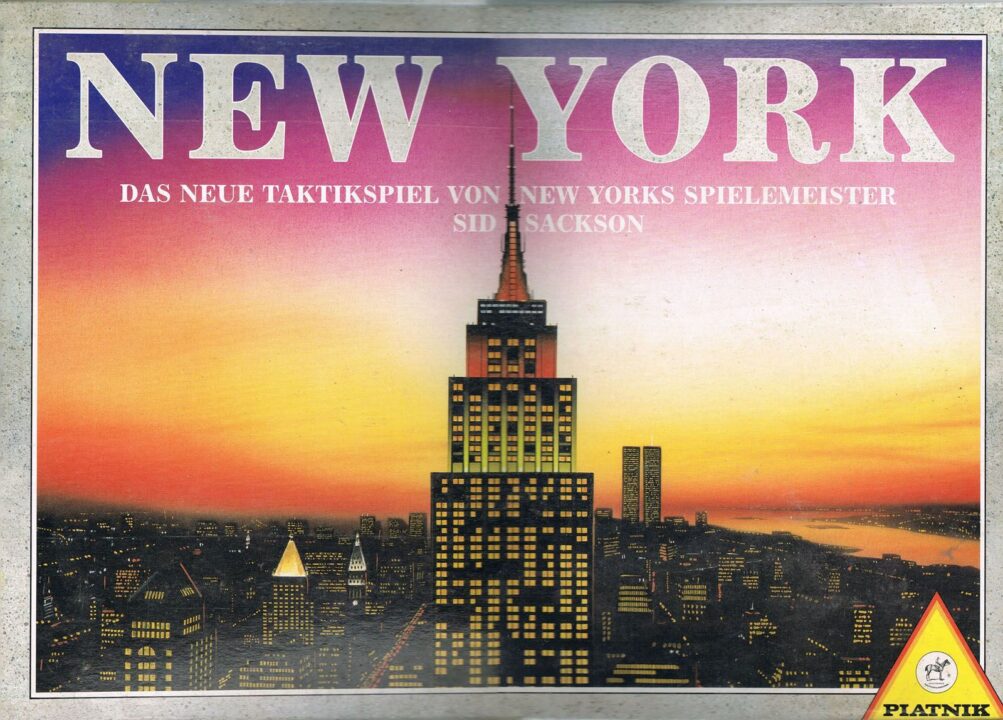Welcome to my review of New York, the board game that had my friends yelling, scheming, and threatening to flip the table (in a loving way). I’ve played this one enough times to quote the rules in my sleep, so if you want the good, the bad, and the stuff that made me question my friendships, you’re in the right place. Get comfy, because I’ve got honest thoughts and a few jokes — and, yes, I promise not to start any real estate wars this time.
How It Plays
Setting up
First, slap that big ol’ New York board on the table. Pass out player pieces, tokens, and those chunky money stacks. Put the building tiles out in neat piles. Give everyone their starting cash (no actual bribery allowed, sadly).
Gameplay
Take turns picking spots, buying buildings, and trying not to tick off your friends too much. You collect rent, build skyscrapers, and watch Cindy try to outbid everyone with her wild “mystery strategy” (I’m still not sure she had one). You’ll need to manage money and plan ahead, but there’s always a bit of chaos (thanks, random event cards!).
Winning the game
The game ends after a set number of rounds or when the city fills up. Count all your stacks—money, buildings, and victory points. Whoever’s got the most wins and gets to brag until someone demands a rematch. Fair warning: expect some grumbling about “next time I’ll be the skyscraper king!”
Want to know more? Read our extensive strategy guide for New York.
How Fair is the Concrete Jungle? Examining the Mechanics of New York
I have played a lot of board games where the rules feel like they were invented by someone who lost a bet, but New York does not fall into that trap. The mechanics of this game have a smoothness that I honestly did not expect. Every move I make feels like it matters. There’s no pointless busywork here – every action has a real effect, whether I’m building skyscrapers or racing a rival to claim a key spot.
Now, let’s talk luck. Sure, the dice make an appearance in New York, but they don’t control the whole show. There’s just enough randomness to keep things spicy, and not so much that I feel like chucking the game out the window after a single bad roll. I’ve seen my friend Joe get a lucky streak, but he still had to make smart choices to stay on top – which I appreciate. If a game lets my uncle Bob win just by getting lucky, it’s dead to me. But here, strategy wins out in the long run.
The balancing act between strategy and chance in New York is pretty darn solid. There were a couple times when I felt like someone fell behind and couldn’t catch up, but usually that was their own doing (sorry, Lisa, you gotta watch those property auctions!). The game keeps things close, but never tips into chaos or unfairness. I never felt like I lost because the game was against me – just because my friends were better (or sneakier) players.
If you like games where you earn your victories and earn your mistakes, New York is a solid pick. Next up, let’s see if the buzz around the table is as lively as Times Square on New Year’s Eve!
Player Interaction and Table Fun Factor in New York
If your idea of fun is sitting quietly and plotting in a corner, New York might feel like a subway ride at rush hour—bustling, loud, and absolutely thrilling. This game doesn’t let anyone at the table snooze. Every turn, you’ll find yourself eyeing what everyone else is doing—sometimes suspiciously—because their moves can totally mess up your plan. And your plan will get wrecked more than once, trust me. My friend Carol tried to play it safe and suddenly lost her skyscraper spot to Dave, the human hurricane. She’s still not over it.
There’s this mechanic where you can snag bonuses right from under someone’s nose if you play your cards right (or wrong, if you ask the person who just lost out). The game doesn’t allow much room for silent strategy. Every decision feels like a group event. You want that prime building spot? Better be ready to negotiate, bluff, or at least bribe your friends with snacks. I’ve seen alliances form and break faster than a New York minute. The table talk is loud, sometimes desperate, but always hilarious. It’s a perfect time for players who like a bit of chaos and healthy competition.
On the downside, if you have a table full of sore losers or folks who hate being interrupted, New York can get messy. But for my group, it’s a laugh riot and has given us plenty of memorable moments. If you enjoy games where you can’t hide in the background and the table gets rowdy, this is your ticket.
Buckle up, because next up, we’ll see if New York’s looks are as wild as its gameplay. Stay tuned for my take on the theme and how snazzy the board actually is!
New York: A City Bursting With Theme and Personality
Let’s talk about New York’s theme and how the game looks on the table, because wow, there’s a lot to say. Picture this: you lift the lid and bam!—that bold skyline art hits you in the eyeballs like a Broadway spotlight. The game board actually feels like a bustling cityscape, complete with skyscrapers so detailed I half-expected a tiny King Kong to swing by. The artwork gives off real ‘never sleeps’ energy, and the color palette pops like a yellow cab in Times Square. No bland brown here, folks!
It’s not just the art. The components in New York are chunky, solid, and look great spread out. The little building pieces make you want to shout “I own that block!” even if your friends glare at you for bragging. Every bit of the design screams ‘theme’, from the card backs that look like subway tickets to the event cards that feel straight out of a New York tabloid. Even the rulebook throws in a few cheeky city puns. I’m a sucker for that kind of detail. My buddy Sarah spent five minutes just admiring the bridges—no joke. It all comes together to make the game feel bigger, brasher and more fun.
If you want a game that could double as coffee table art, New York absolutely delivers. But can you keep wanting to play it, or will it gather dust faster than a forgotten pretzel cart? Stick around, because next up: replay value and if this city’s open 24/7!
Replay Value and Long-Term Engagement: Can New York Keep You Hooked?
When it comes to replay value, New York is sort of like that friend who always brings a wild new story to the table. The more I play, the more twists pop up. The ever-changing board set-up and variety of cards make sure no two games feel the same. My group once played three rounds in a row, and I only flipped the table once (kidding, but those final rounds get heated!).
There’s a real sense of “one more game,” thanks to the fresh combos you can try out every session. You can experiment with different strategies, and even when you think you’ve cracked the code, someone else will come and rain on your parade with a sneaky move. If you like a game where you can try new things and not get bored after four plays, New York does the trick. It feels like there’s always something left to explore, always another way to win (or lose spectacularly, if you’re like me and can’t help poking the bear).
One thing to note: if your group is more about deep, heavy strategy and less about lively chaos, the replay value might take a hit. But if you enjoy a game where the experience changes based on who’s at the table, New York is a solid pick.
So, would I recommend New York? Absolutely—unless you hate surprises and laughter. Then maybe try chess instead.
Conclusion
Alright folks, that wraps up my thrilling journey through New York! This game shines with strong theme, colorful art, and wild group moments. It’s not perfect—the chaos might scare off quiet players, and some luck sneaks in (I still blame my last place finish on the dice, thank you very much). But New York mostly plays fair, stays fresh after many rounds, and looks great on the table. If you enjoy noisy nights, some strategy, and a sprinkle of New York magic, give it a shot. Just don’t blame me when your friend turns into a wannabe tycoon and buys up half the board.


